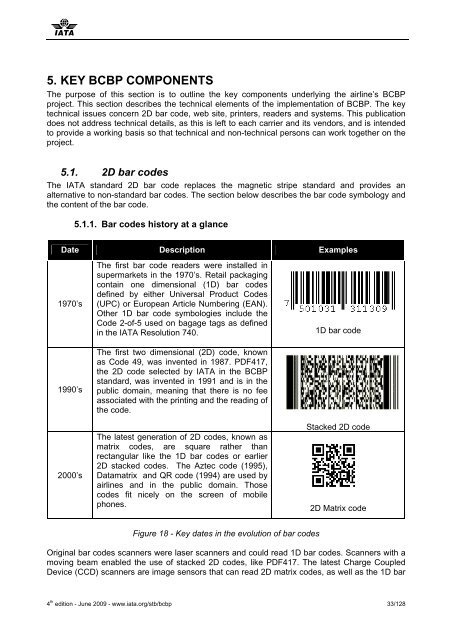Bar-Coded Boarding Passes (BCBP) Implementation guide - IATA
Bar-Coded Boarding Passes (BCBP) Implementation guide - IATA
Bar-Coded Boarding Passes (BCBP) Implementation guide - IATA
Create successful ePaper yourself
Turn your PDF publications into a flip-book with our unique Google optimized e-Paper software.
5. KEY <strong>BCBP</strong> COMPONENTS<br />
The purpose of this section is to outline the key components underlying the airline’s <strong>BCBP</strong><br />
project. This section describes the technical elements of the implementation of <strong>BCBP</strong>. The key<br />
technical issues concern 2D bar code, web site, printers, readers and systems. This publication<br />
does not address technical details, as this is left to each carrier and its vendors, and is intended<br />
to provide a working basis so that technical and non-technical persons can work together on the<br />
project.<br />
5.1. 2D bar codes<br />
The <strong>IATA</strong> standard 2D bar code replaces the magnetic stripe standard and provides an<br />
alternative to non-standard bar codes. The section below describes the bar code symbology and<br />
the content of the bar code.<br />
5.1.1. <strong>Bar</strong> codes history at a glance<br />
Date Description Examples<br />
1970’s<br />
1990’s<br />
2000’s<br />
The first bar code readers were installed in<br />
supermarkets in the 1970’s. Retail packaging<br />
contain one dimensional (1D) bar codes<br />
defined by either Universal Product Codes<br />
(UPC) or European Article Numbering (EAN).<br />
Other 1D bar code symbologies include the<br />
Code 2-of-5 used on bagage tags as defined<br />
in the <strong>IATA</strong> Resolution 740.<br />
The first two dimensional (2D) code, known<br />
as Code 49, was invented in 1987. PDF417,<br />
the 2D code selected by <strong>IATA</strong> in the <strong>BCBP</strong><br />
standard, was invented in 1991 and is in the<br />
public domain, meaning that there is no fee<br />
associated with the printing and the reading of<br />
the code.<br />
The latest generation of 2D codes, known as<br />
matrix codes, are square rather than<br />
rectangular like the 1D bar codes or earlier<br />
2D stacked codes. The Aztec code (1995),<br />
Datamatrix and QR code (1994) are used by<br />
airlines and in the public domain. Those<br />
codes fit nicely on the screen of mobile<br />
phones.<br />
1D bar code<br />
Stacked 2D code<br />
2D Matrix code<br />
Figure 18 - Key dates in the evolution of bar codes<br />
Original bar codes scanners were laser scanners and could read 1D bar codes. Scanners with a<br />
moving beam enabled the use of stacked 2D codes, like PDF417. The latest Charge Coupled<br />
Device (CCD) scanners are image sensors that can read 2D matrix codes, as well as the 1D bar<br />
4 th edition - June 2009 - www.iata.org/stb/bcbp 33/128
















